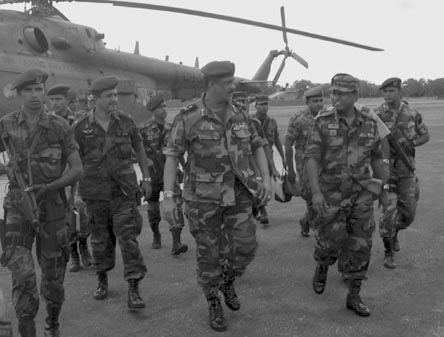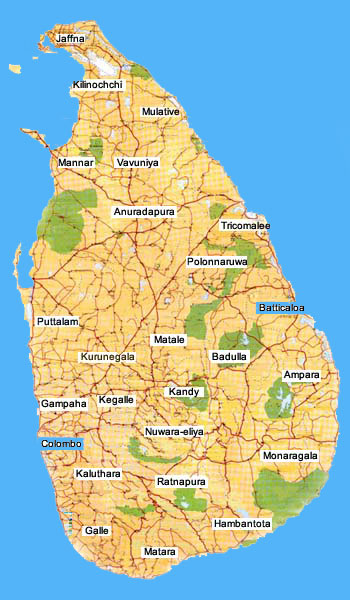Sri Lankan Military Prepares for War
But Talks Less Tough
by Tamil Guardian, June 6, 2007
|
Whilst playing down the military’s ambitions to manage expectations, Fonseka has revised the military plans of capturing the east by mid April and focusing on the north to liberate areas under LTTE administration.
The strategy of the Sri Lankan military now is to clear the east fully, a campaign which according to Fonseka would take another five to six months, and then weaken the LTTE in the north.
|
Even as Sri Lanka’s military prepared for further offensives against the Tamil Tigers’ northern stronghold, the Army’s Commander appeared to sober expectations, saying Colombo has no intention of capturing LTTE-held areas in the north.
“We have no plan to take the North,” Lt. Gen. Sarath Fonseka told foreign journalists on May 28. “Our plan in the North is to weaken the LTTE militarily so that we are able to maintain our positions there.”
His comments were in contrast to his earlier public statements vowing to wipe out the Tigers, whom he insisted were on the verge of collapse.
“After eradicating the Tigers from the East, [the military’s] full strength will be used to rescue the North.” Gen. Fonseaka declared earlier this year.
 |
| Army commander Lt. Gen. Sarath Fonseka visited the eastern warzone last week. Photo SL Army |
President Mahinda Rajapakse, who is also the commander-in-chief of the military has also been backtracked from his earlier pledge to annihilate the LTTE.
Instead, Rajapakse now says his forces are only fighting to contain the LTTE.
“If they stay where they are, keeping their arms, I have no problem with that.” said Rajapakase during an interview with Al Jazeera on June 1.
Earlier this year, after capturing LTTE-administered areas in the east, especially the stronghold at Vaharai and the Paduwankarai area, the Sri Lankan military was visibly brimming with confidence.
However in subsequent months, Colombo’s military strategy has lost momentum.
Firstly, the military is struggling to clear the remaining LTTE-held areas in the east and to control captured areas where a smouldering guerrilla war is dragging on.
Secondly, a series of Sri Lankan military probes in the LTTE-held Vanni in the north have been defeated with casualties.
Also, the military has been trying to make good on Gen. Fonseka’s pledge and break into the LTTE stronghold, but repeated operations in Mannar district have failed to make progress.
Thirdly, there have been successful air raids by the LTTE’s newly unveiled Tamileelam Air Force (TAF) against the main airbase and oil installations in Colombo, as well as the main military base complex in the Jaffna peninsula.
The daring airstrikes by the TAF’s light aircraft have also served to create anxieties about the government’s hardline war strategy and to lower the military’s morale.
On March 26 TAF planes bombed the Katunayake air force base adjacent to Sri Lanka’s only international airport north of Colombo. The raid stunned the government and forcing it to step up its air defences, placing anti-aircraft guns around the city and in other parts of the country.
 However, the security measures proved to be inadequate when TAF planes carried out two more air raids, one targeting Palali military base complex in the Jaffna peninsula, and another targeting oil and fuel storages in and around Colombo. However, the security measures proved to be inadequate when TAF planes carried out two more air raids, one targeting Palali military base complex in the Jaffna peninsula, and another targeting oil and fuel storages in and around Colombo.
The Sri Lankan army first launched an offensive on March 16 with the aim of capturing Palamoddai, northwest of Vavuniya but retreated following 3 hours of heavy fighting.
On 23 March the army tried to advance into [location missing, but assumed to be the Madhu region] using 120 villagers as human shields, but in 15 hours of fierce fighting the LTTE rescued the hostages and pushed the troops back to their original positions in Thampanai and Chinna Pandivirichaan. The army lost 60 soldiers in this operation.
Since then a number of Army pushes into LTTE-held areas of Mannar district, including the Madhu region, have failed.
In the east the Army is struggling to flush the LTTE out from the thick jungles of the Thoppigala region.
The eastern areas captured from the LTTE continue to be volatile with the Tigers carrying out regular ambushes against the military.
Some analysts feel the euphoria in the south following the LTTE’s steady retreats ahead of the military’s offensives was misplaced and argue that the LTTE’s reverting to guerilla tactics from the jungle bases will prove harder to counter.
And in addition to checking Sri Lankan offensives, in recent days the LTTE has also started conducting its own small offensive operations.
On May 24 LTTE marine commandos attacked the Sri Lankan naval detachment in the Delft Island, one of seven islets located west of Jaffna peninsula, killing more than 35 sailors and recovering a large haul of military equipments including anti-aircraft guns and radar.
On June 2 LTTE launched a commando raid on Army camps in the Mannar - Vavuniya border villages pushing back the Sri Lankan military and destroying a Sri Lanka Army artillery launch pad located at Pampaimadu.
The attack, in which the LTTE recovered a significant cache of weapons including armored vehicles, left 20 soldiers dead and 40 injured further denting the military confidence.
The LTTE counter-attacks have dulled the euphoria that was prevalent in the military and amongst Sinhala nationalists a few months ago and raised questions about the viability of the government’s military strategy.
But whilst reluctantly accepting that defeating the LTTE would be harder than initially envisaged, the Rajapakse regime and Sri Lankan military continues to believe in a military solution.
The mass deployment of troops and weapons in the Muhamalai – Nagarkovil forward defence lines (FDL) in Jaffna peninsula for a major assault on Vanni and the hurried purchases of vast quantities of ammunition from China are preparations for a major military campaign.
Whilst playing down the military’s ambitions to manage the expectations, Fonseka has revised the military plans of capturing the east by mid April and focusing on the north to liberate areas under LTTE administration.
The strategy the Sri Lankan military is to clear the east fully, a campaign which according to Fonseka would take another five to six months, and then weaken the LTTE in the north.
He estimates the LTTE strength to be 300 fighters in the east positioned in Thoppigala region.
“It [LTTE in the east] can be flushed out of this area in a couple of weeks and then the mopping up operations would have to be carried out to completely clear the area, and that may take five to six months,” he said.
He claimed that there were only 4,000 LTTE fighters in Vanni and further said: “but they are not its best cadres, if they lose 2,000 cadres, they are finished.”
However, responding to a question if SLA plans a repeat of Operation Jayasikuru, the disastrous 18 month long attempt in 1997-9 to capture Vanni, he responded in the negative.
Paradoxically he argued: “there is no point in entering areas under LTTE's control before it is weakened militarily
.”
|
 Home
Home Archives
Archives
 However, the security measures proved to be inadequate when TAF planes carried out two more air raids, one targeting Palali military base complex in the Jaffna peninsula, and another targeting oil and fuel storages in and around Colombo.
However, the security measures proved to be inadequate when TAF planes carried out two more air raids, one targeting Palali military base complex in the Jaffna peninsula, and another targeting oil and fuel storages in and around Colombo.